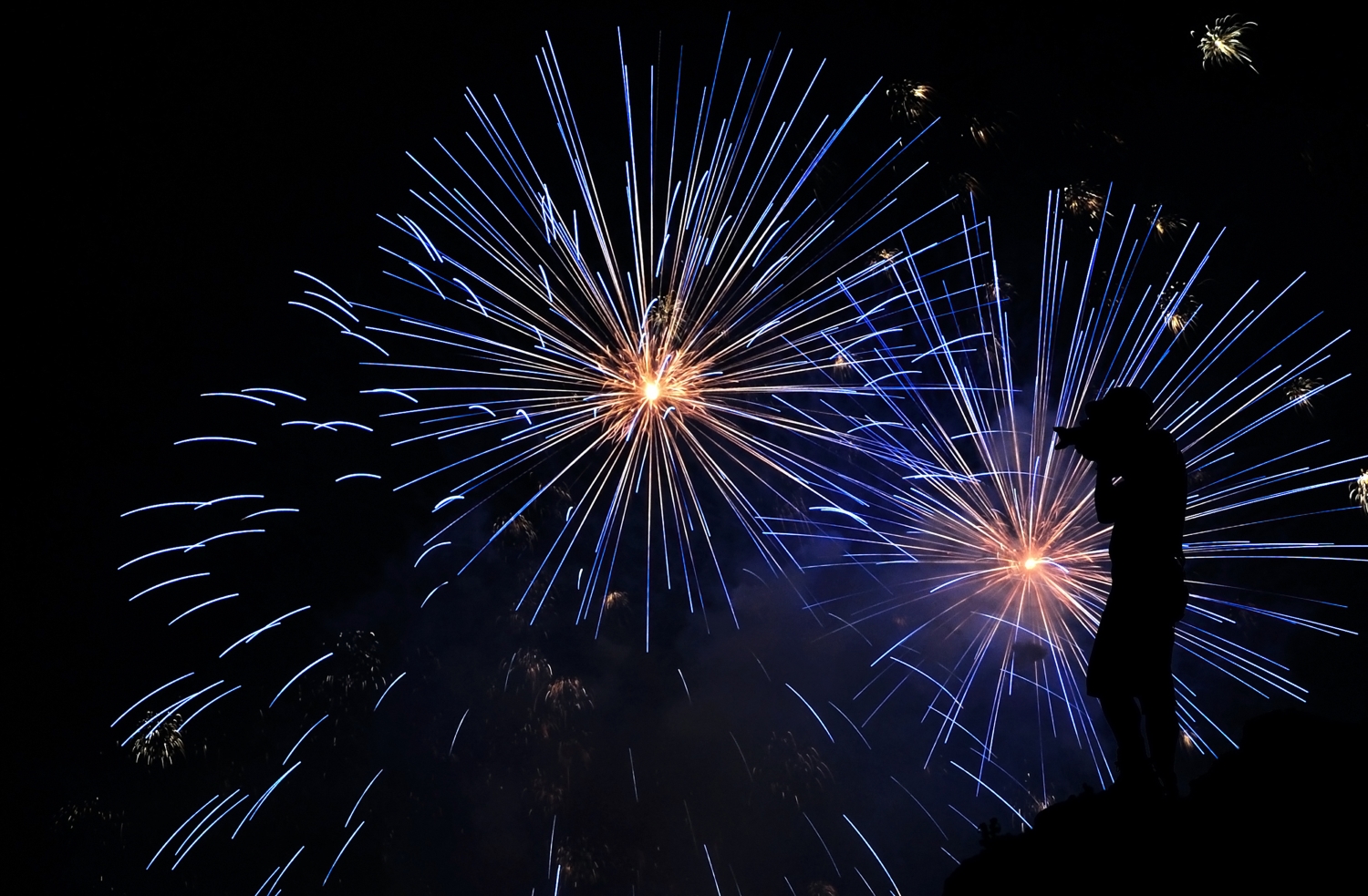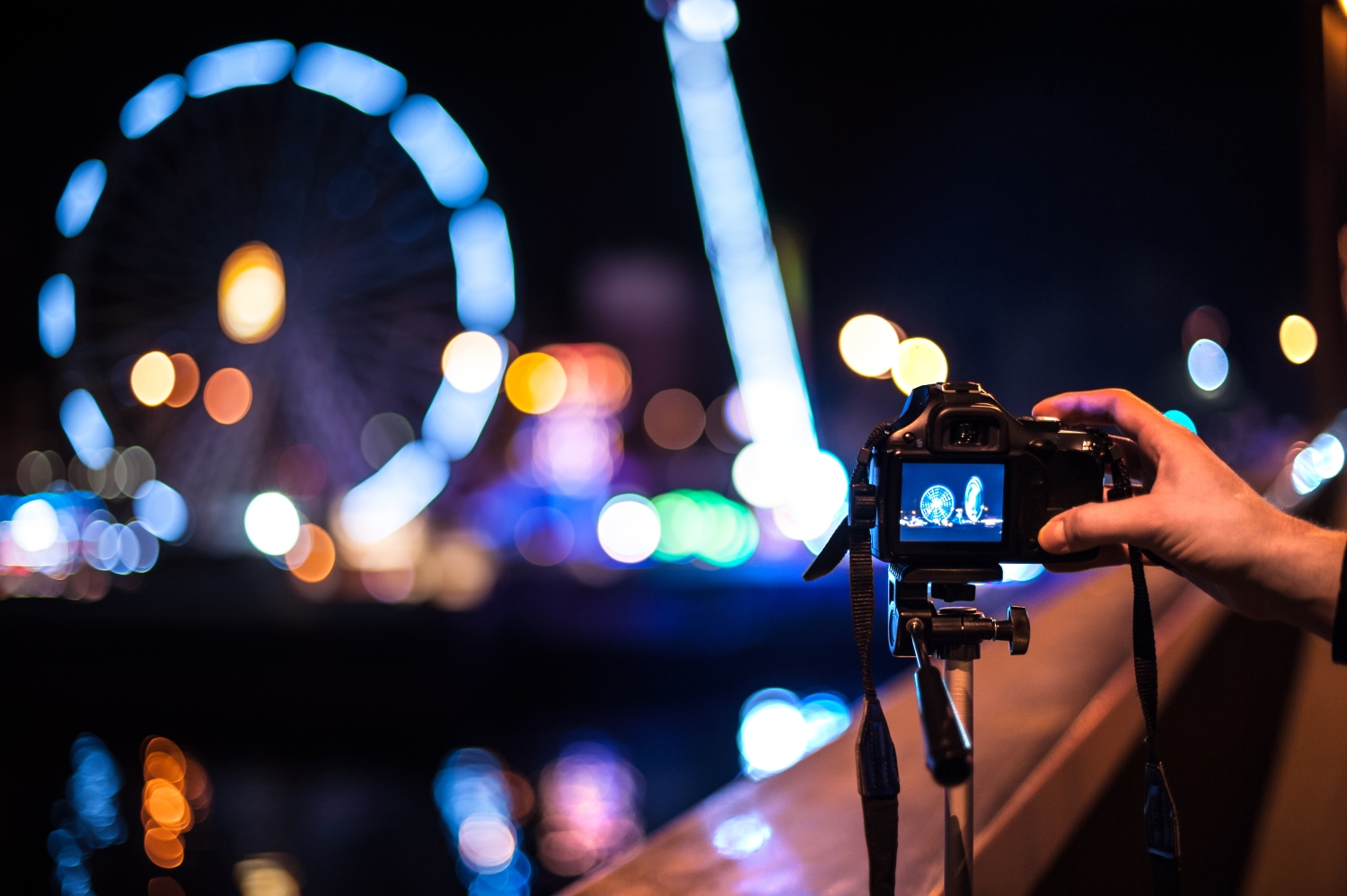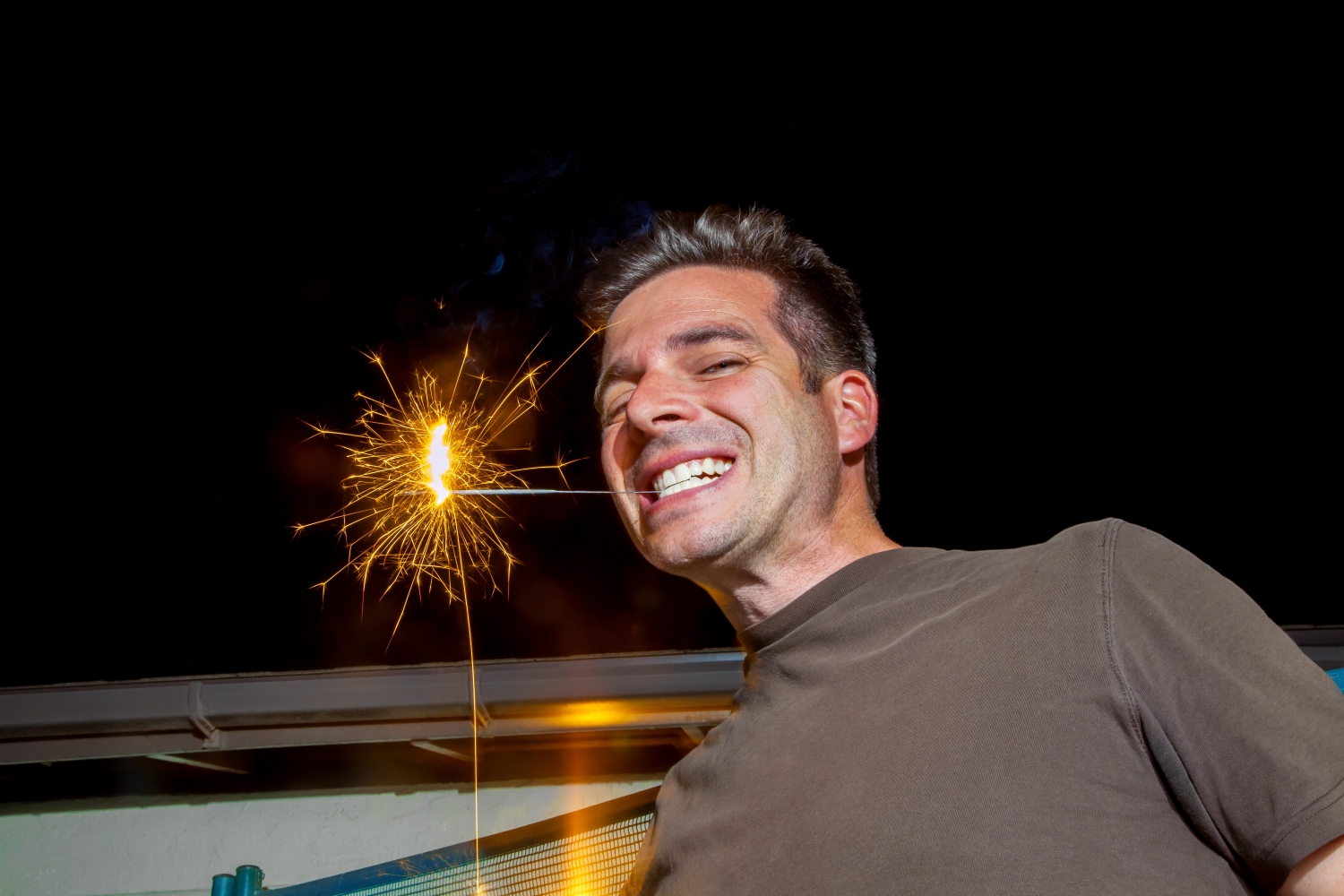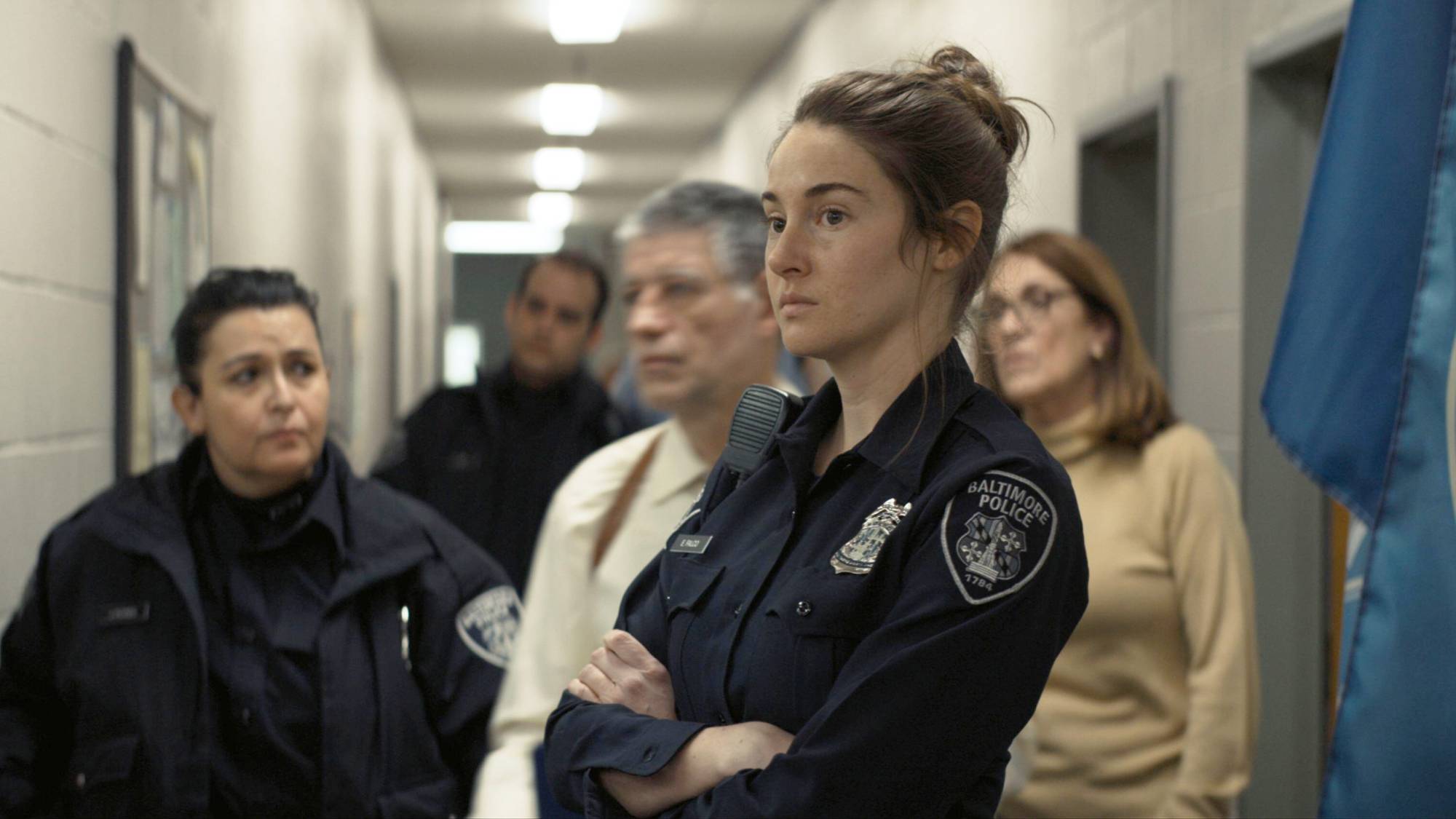How to Photograph Fireworks
Don't settle for blurry, out-of-focus shots of nighttime fireworks. We tell you what to turn off, how to play with composition and what gear you'll need.
A good fireworks display is a spectacle to behold. Exploding blossoms of color and light against the dark sky — shimmering, electric, obscuring the very stars. What phenomenon is more photogenic? And yet, capturing a good photograph of fireworks requires planning and taking control of your camera.

Here are a few tips to help you get great fireworks photos:
1. Take your camera off automatic.
Just snapping away with your camera on auto is unlikely to give you a great photo during a fireworks display. You'll get better results by using manual settings. One exception may be those cameras that have a Fireworks setting. However, not all such pre-programmed settings get the best picture the camera is capable of capturing.
Test the Fireworks setting to see how it does. Then turn it off and use a manual (M) or aperture-priority (A) setting. Start at one-half-second shutter speed at about f11 aperture. Then, experiment. To increase the amount of light in your picture, either raise the shutter speed's length of time (perhaps to a second or two) or decrease the f-stop number. To decrease the amount of light in your pictures, adjust to a faster shutter speed or a higher f-stop number. Don't change both the shutter speed and f-stop number at once, however.
MORE: Best Fireworks Apps
One other key setting that can adjust your camera's sensitivity to light is the ISO sensitivity. We prefer an ISO of 100 or 200 for fireworks. Reduce the ISO to decrease light, and increase it to capture more light. However, the higher the ISO number, the "noisier" you photo may be (i.e., exhibit a multitude of tiny, grain-like dots). Traditionally, professional photographers have tended to avoid ISOs of more than 400-800. But the newest-generation cameras tend to do a decent job of noise suppression at much higher ISOs.
Putting your camera on manual or aperture-priority may sound intimidating, but it's an easy process to master. What's more, not only will that give you more control and a greater likelihood of success with your fireworks photos, but it will also be far more satisfying creatively.
Sign up to get the BEST of Tom's Guide direct to your inbox.
Get instant access to breaking news, the hottest reviews, great deals and helpful tips.
2. Use a tripod.
Whether you use a camera's Fireworks setting or the manual settings below, you'll need to keep your camera rock-solid steady. That's because taking pictures of fireworks requires that your camera shutter be open for a long time. Human bodies are always moving. People breathe; blood pumps through their vessels, and muscles adjust autonomically to maintain current posture. No individuals, no matter how in control of their bodies they think they are, can keep from moving. You may not see or feel it, but your camera will register the motion. The slightest movement during that long exposure will result in a blurred picture. Fixing your camera to a good tripod, which is set on solid ground, will help to keep the camera steady.

By the way, if you don't have a tripod, and don't want to buy one, sit your camera on some solid surface such as a table. However, make sure you and your companions don't touch the table while you're photographing.
A tripod (or solid surface) is only half the equation for a steady camera. Whenever you press the shutter button, you are shaking the camera. So, you'll need to use the camera's remote control (if it came with one), a cable release (if one can be screwed into your camera's shutter button) or the camera's self-timer. One of those options, in combination with a tripod, will give you a shake-free capture.
3. Turn off your flash.
Unless you want to photograph someone or something in the foreground of your shot (with the fireworks in the background), your flash will be useless, since it reaches only a few feet. What's more, having the flash turned on could confuse your camera's exposure settings.
4. Turn off autofocus.
When your camera is set on autofocus, the device constantly analyzes the scene, tries to determine the best focus point and then adjusts to that focus. However, the dark night can confuse this autofocus feature. If someone lights a cigarette nearby or the fireworks reflect on a car hood, your camera may momentarily think that flash of light is the best focus point. As long as the camera keeps whirling in and out of different focus points, you won't be able to take your picture. So make sure the autofocus is turned off.
Sit back and enjoy the fireworks and the people around you.
If you're photographing only the fireworks, set your focus to infinity and leave it there. If you want to include someone or something in the foreground of your picture, you may need to adjust your focus for those pictures. Whenever you recompose your framing, check your focus.
5. Plan ahead.
Check out the location and the lay of the land before the fireworks begin. Where do you think would be the ideal spot to set up for the pictures you have in mind? Is it an area where people won't likely walk (or worse, stand) in front of your camera lens? Will you be able to get to the location when the crowds descend for the actual display? Or should you get there early to reserve your place?
During your planning visit, put your camera on the tripod and see what angles and compositions you'll want to use. Are there interesting landscapes or buildings that you might want to include in some of your images? If so, should the framing be horizontal or vertical for those particular exposures? If you want to include a person in the foreground, where should he or she sit or stand in relation to your tripod and the camera angle?
6. Check your packing list.
Make sure you have the following items easily accessible in your camera bag:
- At least one, but preferably several spare, charged camera batteries
- A bunch of extra memory cards
- Your camera's remote control or cable release
- A small flashlight (to help you see when checking camera settings and exchanging memory cards
If you have a tripod that can telescope so your camera is above the crowd's heads, you may also want to bring a small step.
7. Experiment with composition.

Fireworks provide a great subject on their own. However, putting them within context of the location or the people who are enjoying the display can create a more personal vision and eloquent story. Try some of the following ideas:
- If the fireworks are above a body of water, include the water, which may give you some interesting reflections. Look for other reflections around you (perhaps even behind you) that might be photographically interesting.
- People, mountains, buildings, animals, etc. can all be potentially great compositional elements. In fact, those crowds we mentioned can also add to the captured moment, even if you will usually want to avoid them.
- Play with silhouettes in front of the fireworks.
- Turn on fill flash for some of the pictures, if you want to capture people's expressions or other details in the foreground. (But remember to turn it off when you're done with those pictures.)
- Play creatively with shutter-speed settings. The longer your shutter speed is, the streakier the fireworks will appear in your picture.
- Try some double or multiple exposures. If your camera doesn't have a double exposure setting, set your shutter speed at something very slow (say, four seconds or more). Then, between bursts of fireworks, cover the lens with a black matte board, removing it only long enough to add the next set of fireworks to the exposure … then the next.
While you continue to play with new compositions, periodically check to make sure your horizon is straight, your focus is appropriate and your exposure is just right.
8. Enjoy the fireworks.
Don’t keep checking your LCD screen after every shot. Not only does that drain your battery, but it also defeats the primary purpose of being there. Sit back and enjoy the fireworks and the people around you. Your pictures will be great mementos of the evening. But living the moment and sharing the fireworks are what will make the pictures really meaningful memories.
Sally Wiener Grotta is the president and lead analyst of DigitalBenchmarks test lab (www.DigitalBenchmarks.com). The scripts she created for various tech publications for testing and evaluating digital cameras, image quality, software and related technologies have become industry standards. Among her numerous books is the first major volume on image processing “Digital Imaging for Visual Artists” (McGraw-Hill), co-authored with Daniel Grotta. Her hundreds of reviews, stories and columns have appeared in scores of magazines, journals and online publications.

